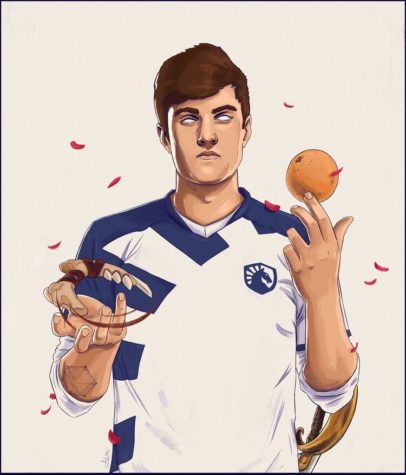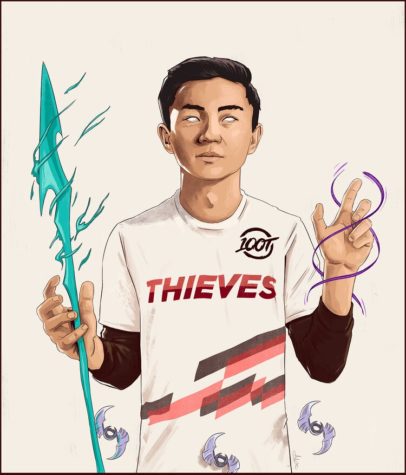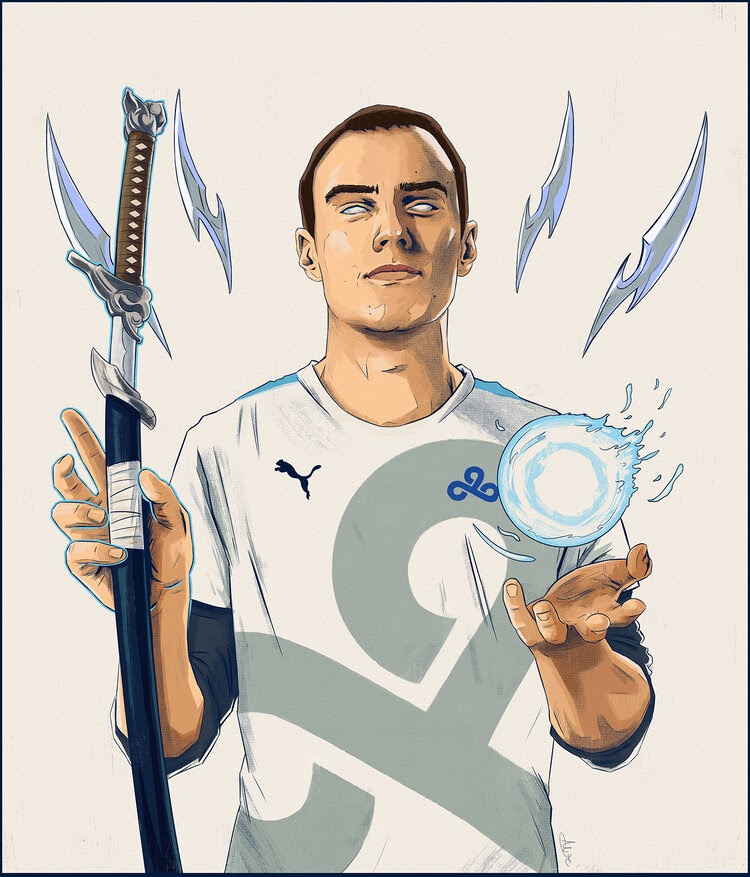It’s Global Warfare in the League of Legends Esports — For Whom Will You Cheer?
It’s that time of year again, After a year of roster switches and upsets, League of Legends 2021 worlds has begun!
Ali Hassanein, @alihassanein on Instagram and Twitter
Cloud9, the third seed of North America represented by Perkz (Luka Perković). The sword represents Yasuo, the blades behind him represent Irelia and the spectral orb in his right hand represents Ahri.
As COVID-19 mandates slowly begin to lift, the world of sports is beginning to flourish once more. Home audiences are captivated, watching hours of content on television, all while cheering for their favorite teams to emerge victorious. This is no different for fans of Esports, an industry that took an unexpected hit from COVID-19 restrictions.
In 2021, the League of Legends (LoL) World Championship finally reopened its doors to teams from dominant regional leagues such as China’s LPL, Korea’s LCK, North America’s LCS, and Europe’s LEC.
One of the most talked about events to begin the World Championships was the drawing of groups. Before the games actually began, 16 teams were divided into four groups, each with four teams. The top three teams from China, Korea and Europe, as well as the top two teams from North America and the top team from the PCS (Hong Kong, Macau & Taiwan) were to automatically advance to the group stage.

Before the tournament began, clear favorites emerged in the Chinese and Korean teams, with both having a reputation of being the best teams in the world. The 2019 winner, China’s FunPlus Phoenix (FPX) and last years’ winner, Korea’s Damwon KIA (DK) have consistently been hyped up by analysts. Their star players: FPX’s Doinb (Kim Tae-sang) and DK’s ShowMaker (Heo Su) were seen as the worlds’ best.
Additionally, some of the fan favorite teams such as Korea’s T1, a previous three-time Worlds Winner and their long-lasting star player, Faker (Lee Sang-hyeok), were also in attendance.
As groups were drawn, many were excited to see which teams would eventually make it to the quarter-finals. Compared to other years, the drawn groups were very diverse with no clear winner contenders.
The part of the tournament that seemed to shock fans world-wide was the results of Group A.
Group A consisted of both powerhouse teams, FPX and DK, as well as the two western teams, Europe’s Rogue and North America’s Cloud9. Many believed that this would be the most predictable group to watch as FPX and DK seemed unbeatable.
During the first days of groups, western fans watched Cloud9 and Rogue lose game after game, with Cloud9 ending the week winless. Last year, a similar story occurred with one of the other North American teams, Team SoloMid (TSM). At the end of the group stage, what was considered North America’s best team could not win a single game, having especially bad losses to teams that were not even considered Korea or China’s finest. It was an embarrassment. “When it comes to Worlds, North America never seems to want to win. It’s hard to say if things will change for the better. There’s a huge disparity between the Western and Asian teams,” said Tahmid Tapan ’22.
But for the first time in over three years, North American prayers were answered. On the fourth day, Cloud9 started strong, winning a game against Rogue in only twenty-five minutes. The team then went on to sweep FPX in a dominating twenty-eight minute game. After Rogue won against FPX, North American and European fans alike began to feel confident. The untouchable FPX had fallen to be equal to the third seed from both of the western leagues.
In the case of a three-way tie, the team advancing would be based on shortest game length, which went in Cloud9’s favor thanks to their fast-paced early style. After Rogue beat FPX again, completely knocking them out of the tournament, a final tie-breaker between Cloud9 and Rogue ensued.
The match was tense, the fate of both teams rested on this singular game. Both teams played safe and erred on the side of caution, stretching the game out to over fifty minutes long. The final play came in the form of a hail-mary from Rogue in an attempt to stop Cloud9 from earning a deceive objective that likely would have led to an easy victory. Yet, all hope was lost for European fans as they watched Rogue fall to North Americans.
For the first time since 2018, North America progressed to the quarter-finals.

Getting out of the quarter-finals is another story. The quarter-finals draw was disappointing for many fans.
The two Chinese teams that made it out of the group stage, Royal Never Give Up (RNG) and Edward Gaming (EDG), were drawn against one another, making it impossible for both Chinese teams to make it to the semi-finals. After a tense best-of-five series that was packed with close comebacks, EDG won, three wins to two losses.
The fan favorite T1 was pit against another Korean team, Hanwha Life Esports (HLE). This matched T1’s star player Faker against HLE’s Chovy (Jeong Ji-hoon), a new rising talent who’s been universally praised by analysts. In the end, T1 had a clean sweep of HLE, not losing a single match.
In the two other quarter finals, the European first seed, MAD Lions, were matched up against DK, while Cloud9 faced up against another Korean team, Gen.G (GENG). Both the MAD lions and Cloud9 lost, with neither taking a single game off of their Eastern opponents.
While it was sad to lose the European and North American teams early, the semi-finals made up for the disappointment.. Both games, EDG vs GENG and DK vs T1, required all five games to be played to determine an outright winner.
DK and T1 fought first in the most popular non-finals game of the tournament, peaking at over 3.5 million live viewers.
DK took an early lead, but T1 struck back with a dominant performance against the previous world champions, swiftly taking the following two games. DK quickly struck back, taking the fourth game and leaving the two teams tied at two games apiece.
The final game was incredibly tense. T1 took off with an early lead, but DK was slowly making up for their losses by sieging on important objectives that would give team-wide buffs to all of its players. In a scuffle for one of these objectives, T1 was split apart and cornered, which allowed DK to seize their lead and finish T1 off.
EDG and GENG also had an impressive series, even though their matchup was not as popular. In the same fashion, as DK vs T1, EDG won game one while GENG took the second and third games. The fourth game was when the tides began to turn as EDG held up a dominant performance, especially their two key players, Scout (Lee Ye-chan) and Viper (Park Do-hyeon).
Unlike T1, the last game was a blowout. EDG held up a dominant performance that led their team to have a strong final score.
Going into the finale, there were some complications. While the group stage was very quick-paced due to the very small time delay periods, the wait from semi-finals to finals was incredibly long.
Viewers began to lose interest due to the lapse in games, even so, the final series reached a peak viewership of over 4,000,000 active viewers, not including Chinese platforms, which make up the majority of the League of Legends audience.
DK versus EDG was a five-game epic. Before the game began, many viewers believed this series would be a clean sweep. While EDG were still a dominant team, they had a much easier path to victory compared to DK.
The best-of-five series against GENG, a much lower seeded team, showed their weaknesses against a Korean. In comparison, DK played against T1, a team that looked incredibly clean throughout the tournament and a strong contender if put against either GENG or EDG.
With expectations at their lowest, the world watched as EDG dismantled DK in the first game. Although similar to many other games throughout the tournament, DK began their own rampage, winning two straight games and taking the lead in the score line. In the following games, EDG began to find their groove, creating openings and getting objectives for a slow victory.
The final game was incredibly eventful: EDG got an early lead, targeting DK’s Khan (Kim Dong-ha) after he found himself out of position. Using these misplays, EDG’s Flandre (Li Xuan-Jun) got a major advantage, making him unstoppable. This led to early objectives, and, as DK grew more desperate, they attempted to make riskier plays for greater rewards, but ultimately failed. In the end, DK was usurped as the reigning kings and replaced by the new world champions: Edward Gaming.
Now that the curtains have closed on the world events, Riot, the developer of the game, seems excited for future endeavors involving League of Legends and its surrounding media. Next season there have been rumors of the possibility of a double-elimination format, which would lead to a much more exciting tournament. It would provide more international best-of-fives as well as give way to more possible underdog storylines.
As Riot grows bigger and League of Legends expands, Esports will grow with it. As a frontrunner in Esports media, companies look up to these major tournaments, and there is likely no other company better to be such a leader in the industry. Riot’s most recent release, Arcane, a Netflix animated series based on some of the lore and characters within League of Legends, has been a major hit, bringing attention to the company, game and the recent championship.
As for next Worlds, we can only hope that borders will lift and communications open up to offer a more dynamic fan experience. And maybe, us North Americans will finally have a chance to host the tournament and have easy access to its viewing.
Now that the curtains have closed on the world events, Riot, the developer of the game, seems excited for future endeavors involving League of Legends and its surrounding media.
Sophie Livingstone is an Editor-in-Chief for ‘The Science Survey.’ She enjoys both journalistic and creative writing and the influence that one can...

